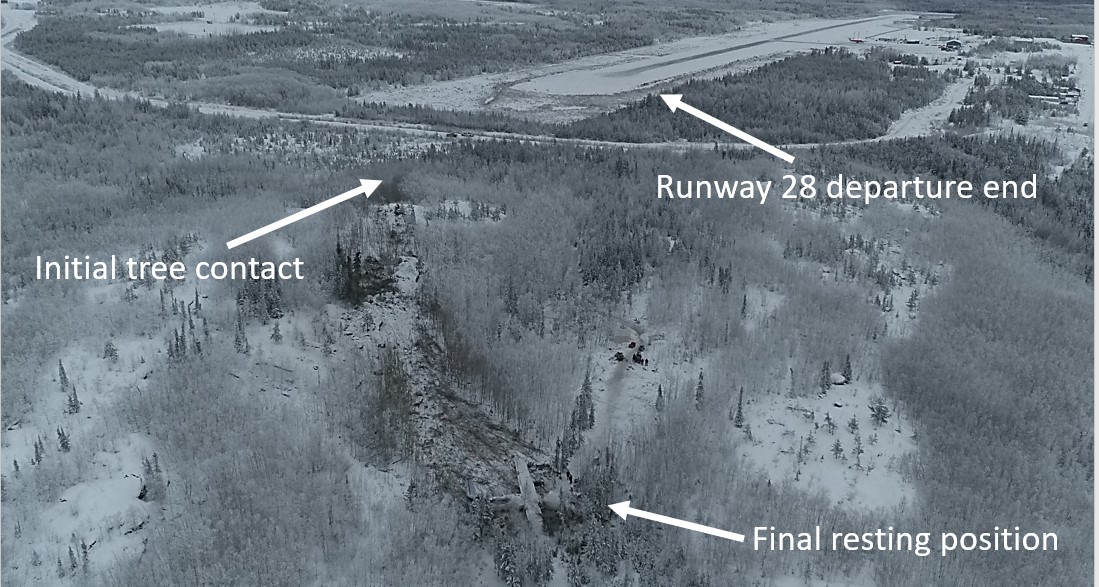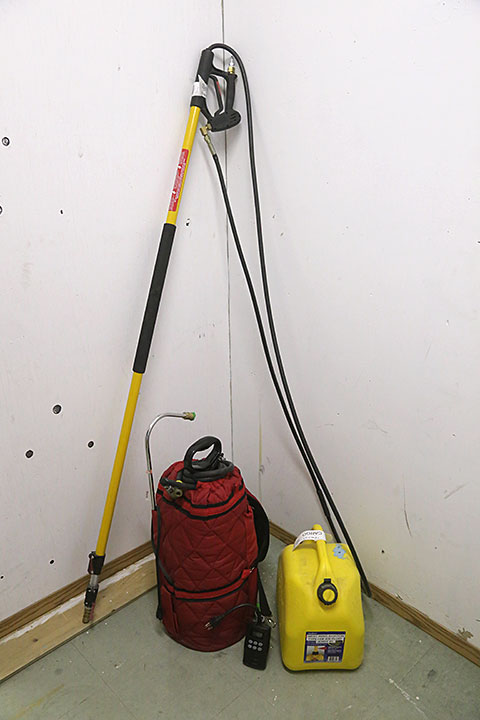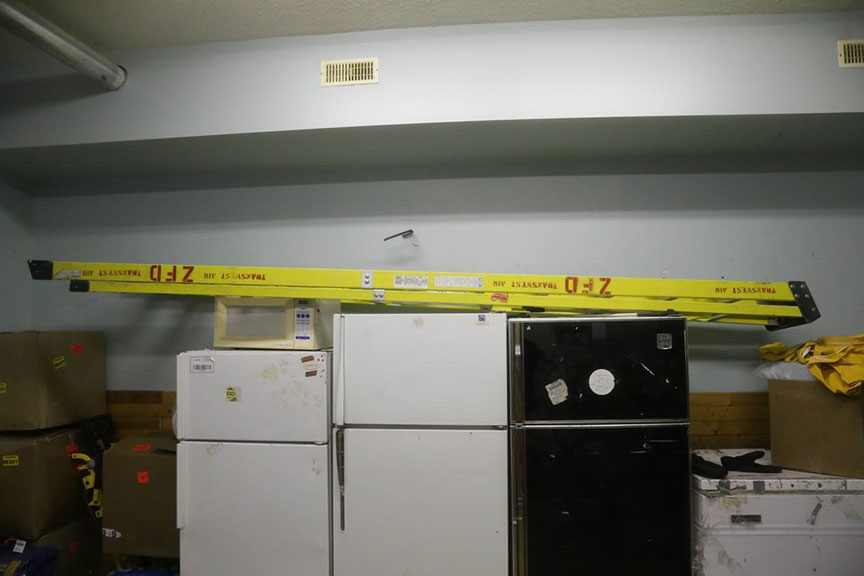The Transportation Safety Board of Canada (TSB) determined a lack of adequate de-icing equipment and the practice of taking off without de-icing led to the 2017 plane crash in Fond-du-Lac, Sask.

There were 22 passengers and three crew members on board the West Wind Aviation ATR-42 aircraft. All were injured in the crash, ten seriously. One passenger died days later.
The findings were released on Thursday in an investigation report by TSB.
On Dec. 13, 2017, the aircraft departed Fond-du-Lac Airport for Stony Rapids, Sask.
The aircraft collided with trees and terrain about 450 metres west of the departure end of Runway 28.
“Early in the investigation, it was determined that the aircraft took off from Fond-du-Lac Airport with ice contamination on the aircraft’s critical surfaces,” TSB said in a release.
The operator had “some de-icing equipment” in the terminal building, but TSB says it was “not adequate” for de-icing an ATR-42 aircraft.
In 2018 the TSB recommended making sure there was adequate de-icing and anti-icing equipment available for operators who need it. TSB also recommended Transport Canada “take action to improve compliance with the regulations to reduce the likelihood that crews take off with snow or ice contamination.”
Transport Canada told Global News they have taken measures to address both of these recommendations.
The investigation also found that “well before the accident” the aircraft encountered icing conditions during the descent toward Fond-du-Lac.
“The flight crew activated both the anti-icing and de-icing systems, but some ice remained on the aircraft. However, the crew did not notice any handling abnormalities and landed without incident.”

TSB said 45 minutes before the flight took off, icing conditions were still present and more ice had formed on the aircraft.

Get breaking National news
“After carrying out a pre-flight inspection, the first officer notified the captain of the presence of some ice on critical surfaces, but there was no further discussion or action taken.”
“Because the available inspection equipment was inadequate, the first officer’s ice inspection consisted of walking around the aircraft, at night, on a dimly lit apron, without a flashlight, and looking at the left wing from the top of the stairs at the left rear entry door. As a result, the full extent of the residual ice and ongoing accretion was unknown to the flight crew.”
TSB said departing from remote airports like Fond-du-Lac with “some amount of surface contamination” on the plane’s critical surfaces had become a common practice.
This was in part due to the “inadequacy of de-icing equipment or services at these locations.”
“The past success of these adaptations resulted in the unsafe practice becoming normalized and this normalization influenced the flight crew’s decision to depart,” TSB said.
“During takeoff, the aircraft initially climbed; however, immediately after liftoff, the aircraft began to roll to the left without any pilot input. This roll was as a result of asymmetric lift distribution due to uneven ice contamination on the aircraft.”
“This loss of control in the roll axis, which corresponds with the known risks associated with taking off with ice contamination, ultimately led to the aircraft colliding with terrain.”
The TSB found that relaxed de-icing measures aren’t isolated to Saskatchewan.
The TSB conducted a survey as part of this investigation which found 75 per cent of pilots who fly into remote northern airports said they had taken off with contaminated critical surfaces.
“That’s a systemic problem that has to be addressed by a combination of Transport Canada regulations and enforcement as well as operators and airport authorities,” TSB chair Kathy Fox said during a press conference Thursday.
TSB added following the plane hitting the ground, “the survivable space between the floor above the main landing gear and the collapsed upper fuselage and the structure was reduced.”
TSB said this led to severe injuries suffered by passengers seated in this area, included the subsequent death of one passenger.
“The design standards in effect at the time the ATR 42 was certified did not specify minimum loads the structure must be able to tolerate to allow a survivable space or minimum loads for fuselage impact energy absorption. As a result, the ATR 42 was not designed with these crashworthiness principles in mind.”
TSB said following the incident, West Wind, now known as Rise Air Aviation, has taken steps to improve internal risk assessments and now provides additional training, guidance, and better de-icing equipment to crews.
On Thursday, Rise Air president and CEO Derek Nice apologized to the passengers and crew members on the flight.
He added safety management systems at every airport serviced by Rise Air have been upgraded.
The full 240-page investigation report can be found on TSB’s website.
Transport Canada responds to findings
In a statement sent to Global News, a spokesperson with Transport Canada said their thoughts go out to those affected by the tragedy.
Transport Canada welcomes the TSB’s final investigation report and officials are reviewing the findings.
“Transport Canada shares the Transportation Safety Board of Canada’s goal of improving the safety of Canada’s transportation network and takes all recommendations made by the Board seriously,” the statement read.
The statement explained that Transport Canada carried out a targeted inspection campaign during the 2019 to 2020 winter season, conducting on-site observations of de-icing and anti-icing practices.
This is to ensure operators were implementing proper de-icing procedures. The campaign was halted in March 2020 due to the COVID-19 pandemic but is set to resume in the upcoming winter.
“In March 2021, Transport Canada conducted on-site inspections of 18 airports in the three northern territories. No evidence of high-risk safety issues in relation to de-icing practices were identified. The inspections of northern airports enabled meaningful, face-to-face engagement with industry operating in remote parts of Canada.”
Transport Canada also implemented a de-icing and anti-icing working group.
“In 2019, Transport Canada established a working group comprised of aviation stakeholders, with the objective of improving the availability of de-icing/anti-icing equipment and increasing its proper use. The working group has identified locations where challenges exist with respect to adequate de-icing/anti-icing equipment and infrastructure.”
Since its first meeting in Oct. 2020, the group has met five times and will continue to meet regularly, Transport Canada said.
During this fall, the group is putting out a survey with northern and remote pilots and air operators to gather more information on existing de-icing and anti-icing equipment.
The full 2investigation can be found on TSB’s website.
— with files from Kyle Benning















Comments